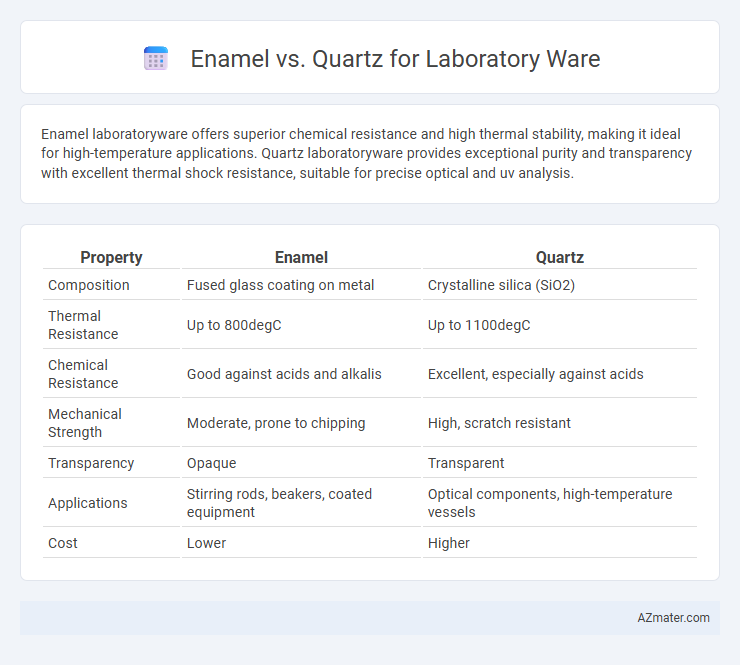Enamel laboratoryware offers superior chemical resistance and high thermal stability, making it ideal for high-temperature applications. Quartz laboratoryware provides exceptional purity and transparency with excellent thermal shock resistance, suitable for precise optical and uv analysis.
Table of Comparison
| Property | Enamel | Quartz |
|---|---|---|
| Composition | Fused glass coating on metal | Crystalline silica (SiO2) |
| Thermal Resistance | Up to 800degC | Up to 1100degC |
| Chemical Resistance | Good against acids and alkalis | Excellent, especially against acids |
| Mechanical Strength | Moderate, prone to chipping | High, scratch resistant |
| Transparency | Opaque | Transparent |
| Applications | Stirring rods, beakers, coated equipment | Optical components, high-temperature vessels |
| Cost | Lower | Higher |
Introduction to Laboratoryware Materials
Laboratoryware materials like enamel and quartz differ significantly in durability, thermal resistance, and chemical inertness, which impact their suitability for various lab applications. Enamel, a glassy coating fused onto metal, offers excellent corrosion resistance and ease of cleaning but may chip under mechanical stress. Quartz provides superior thermal stability and chemical purity, making it ideal for high-precision experiments requiring contamination-free conditions and extreme temperature variations.
What is Enamel Laboratoryware?
Enamel laboratoryware is made by fusing powdered glass to a metal substrate, typically steel or cast iron, at high temperatures to create a durable, chemically resistant surface. This coating provides excellent resistance to acids, alkalis, and corrosion, making enamelware ideal for handling aggressive chemicals in lab settings. Compared to quartz, enamel offers superior impact resistance and cost-effectiveness but may be less resistant to thermal shock and extreme temperatures.
What is Quartz Laboratoryware?
Quartz laboratoryware is made from high-purity silica, offering exceptional thermal resistance and chemical inertness ideal for precise scientific experiments. Compared to enamel, quartz provides superior transparency to UV light, enabling enhanced spectroscopic analysis and accurate temperature measurements. Its durability against thermal shock and aggressive chemicals makes quartz a preferred choice for high-performance laboratory applications requiring reliability and purity.
Chemical Resistance: Enamel vs Quartz
Quartz laboratoryware offers superior chemical resistance, withstanding aggressive acids, bases, and organic solvents without degradation or leaching. Enamel, while resistant to many chemicals, can chip or crack under exposure to strong alkaline solutions and hydrofluoric acid, compromising its protective coating. Therefore, quartz is preferred in laboratories requiring durable, inert surfaces for highly reactive or corrosive substances.
Thermal Stability and Heat Tolerance
Enamel laboratoryware offers high thermal stability with the ability to withstand rapid temperature changes due to its durable glass coating fused to metal substrates. Quartz laboratoryware excels in heat tolerance, maintaining structural integrity at extreme temperatures up to 1,100degC, making it ideal for high-temperature applications. While enamel is resistant to moderate heat and thermal shock, quartz provides superior performance in environments requiring consistent thermal endurance and minimal thermal expansion.
Durability and Mechanical Strength Comparison
Quartz laboratoryware offers superior mechanical strength and resistance to thermal shock compared to enamel, making it ideal for high-precision applications involving rapid temperature changes. Enamel surfaces, while chemically resistant and cost-effective, tend to chip or crack under mechanical stress, reducing overall durability. The dense, non-porous nature of quartz ensures longer-lasting laboratory tools capable of withstanding repeated impacts and abrasive conditions.
Cost and Availability Factors
Enamel laboratoryware offers lower initial costs and broad availability due to widespread manufacturing and traditional use, making it a budget-friendly choice for many labs. Quartz laboratoryware, while more expensive upfront, provides superior thermal and chemical resistance, justifying its higher price when specialized applications demand durability. Availability of quartz items can be limited and lead times longer, influencing laboratory procurement decisions based on immediate need versus long-term investment.
Application Suitability in Laboratory Settings
Enamel laboratoryware offers excellent chemical resistance and thermal stability, making it ideal for high-temperature experiments and applications involving strong acids or alkalis. Quartz laboratoryware provides superior optical clarity and thermal shock resistance, which suits photometric analyses and procedures requiring rapid temperature changes. Selecting between enamel and quartz depends on the specific laboratory application, balancing the need for chemical durability against optical precision and thermal responsiveness.
Maintenance and Cleaning Considerations
Enamel laboratoryware offers a smooth, non-porous surface that resists staining and is generally easy to clean with mild detergents, though it can chip under impact, requiring careful handling to prevent contamination. Quartz laboratoryware, known for its chemical inertness and thermal resistance, withstands aggressive cleaning agents and high-temperature sterilization, making it highly suitable for demanding laboratory environments. Both materials require appropriate cleaning protocols to maintain integrity, but quartz tends to have superior durability against abrasion and chemical corrosion compared to enamel.
Choosing the Right Material: Enamel or Quartz
Choosing between enamel and quartz for laboratoryware depends on the specific chemical resistance, thermal stability, and durability required. Enamel offers excellent resistance to corrosion and high temperatures, making it ideal for general-purpose lab equipment, while quartz provides superior purity, low thermal expansion, and exceptional optical properties suited for precise analytical applications. Selecting the right material ensures optimal performance, longevity, and compatibility with experimental conditions.

Infographic: Enamel vs Quartz for Laboratoryware
 azmater.com
azmater.com